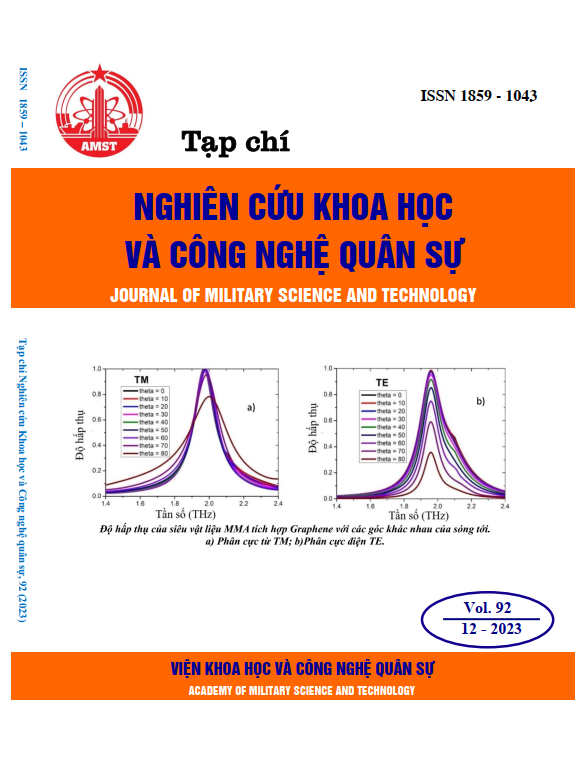Giảm thấp điện áp dẫn của bộ vi kích hoạt điện nhiệt dạng dầm chữ V bằng phương pháp phún xạ bề mặt
279 lượt xemDOI:
https://doi.org/10.54939/1859-1043.j.mst.92.2023.21-29Từ khóa:
Bộ kích hoạt hình chữ V; Hiệu ứng giãn nở nhiệt; Phún xạ bề mặt; Công nghệ vi cơ khối.Tóm tắt
Bài báo giới thiệu phương pháp giảm điện trở bề mặt của bộ vi kích hoạt điện nhiệt dạng chữ V, từ đó, giảm điện áp dẫn, nâng cao chuyển vị, tỷ trọng công suất của bộ vi kích hoạt. Các bộ vi kích hoạt được chế tạo từ phiến silic kép (SOI- Silicon on Insulator) theo quy trình gia công vi cơ khối (Bulk – micromachining), trong đó có cải tiến bổ sung thêm quy trình phún xạ bề mặt bằng vật liệu platin với các thời gian phún xạ thử nghiệm lần lượt là 1,5; 3 và 6 phút. Kết quả cho thấy điện trở bề mặt của bộ vi kích hoạt giảm đi tương ứng 1,16; 1,55 và 2,4 lần so với khi chưa thực hiện phún xạ. Bằng thực nghiệm cũng xác định được chuyển vị của bộ vi kích hoạt có thể tăng 1,45 lần ở dải điện áp từ 8 ÷ 20 V. Điều đó cho ta xác định hiệu quả và tỷ trọng công suất của bộ vi kích hoạt tăng cao hơn so với không thực hiện phún xạ.
Tài liệu tham khảo
[1]. Fang, K.; Hu, T.; Jiang, X.; Zhao, Y. “Research on a MEMS based encrypted rotary safety and arming device”, Sensor Actuators A Phys, 301, 111781 (2020). DOI: https://doi.org/10.1016/j.sna.2019.111781
[2]. Zhaoxin Lao, Neng Xia, Shijie Wang, Tiantian Xu, Xinyu Wu and Li Zhang, “Tethered and Untethered 3D Microactuators Fabricated by Two-Photon Polymerization: A Review”, Micromachines (Basel), 12(4): 465 (2021). DOI: https://doi.org/10.3390/mi12040465
[3]. Zhang Z., Yu Y., Liu X., Zhang X., “Dynamic modelling and analysis of V- and Z-shaped electrothermal Microactuators”, Microsystem Technologies., 23(8), 3775–3789 (2017). DOI: https://doi.org/10.1007/s00542-016-3180-0
[4]. Z. Zhang, Y. Yu, X. Liu and X. Zhang, “A comparison model of V- and Z-shaped electrothermal Microactuators”, 2015 IEEE International Conference on Mechatronics and Automation (ICMA), Beijing, 1025-1030 (2015). DOI: https://doi.org/10.1109/ICMA.2015.7237626
[5]. Li, X.; Zhao, Y.; Hu, T.; Xu, W.; Zhao, Y.; Bai, Y.; Ren, W, “Design of a large displacement thermal actuator with a cascaded V-beam amplification for MEMS safety-and-arming devices”, Microsystem Technologies, 21, 2367–2374 (2015). DOI: https://doi.org/10.1007/s00542-015-2447-1
[6]. Dongpeng Zhang, Anjiang Cai, Yulong Zhao and Tengjiang Hu, “Macro Modeling of V-Shaped Electro-Thermal MEMS Actuator with Human Error Factor”, Micromachines, 12, 622, (2021). DOI: https://doi.org/10.3390/mi12060622
[7]. HamedMajidi Fard-VatanMohsenHamedi, “Design, analysis and fabrication of a novel hybrid electrothermal microgripper in microassembly cell”, Microelectronic Engineering Volume 231, 15, 111374, (2020). DOI: https://doi.org/10.1016/j.mee.2020.111374
[8]. Guoning Si,Liangying Sun, Zhuo Zhang and Xuping Zhang, “Design, Fabrication, and Testing of a Novel 3D 3-Fingered Electrothermal Microgripper with Multiple Degrees of Freedom”, Micromachines, 12(4), 444, (2021). DOI: https://doi.org/10.3390/mi12040444
[9]. Hu T., Zhao Y., Li X., Zhao Y., Bai Y., “Integration design of MEMS electro-thermal safety-and-arming devices”. Microsyst. Technol., 23(4), 953–958, (2017). DOI: https://doi.org/10.1007/s00542-016-2901-8
[10]. Shen, X.; Chen, X., “Mechanical performance of a cascaded V-shaped electrothermal actuator”, Int. J. Adv. Robot. Syst., 10, 379, (2013). DOI: https://doi.org/10.5772/56786
[11]. Park, J.S.; Chu, L.L.; Oliver, A.D., “Gianchandani, Y.B. Bent-beam electrothermal actuators-Part II: Linear and rotary microengines”, J. Microelectromech. Syst., 10, 255–262, (2001). DOI: https://doi.org/10.1109/84.925774
[12]. Zhang Z., Zhang W., Wu Q., Yu Y., Liu X., Zhang X., “Closed-form modelling and design analysis of V- and Z-shaped electrothermal Microactuators”, J. Micromech. Microeng., 27(1), 015023, (2017). DOI: https://doi.org/10.1088/1361-6439/27/1/015023
[13]. Lott C. D., McLain T. W., Harb J. N., Howell L. L., “Modeling the thermal behavior of a surface-micromachined linear-displacement thermomechanical microactuator”, Sens. Actuators: A Phys., 101(1–2), 239–250, (2002). DOI: https://doi.org/10.1016/S0924-4247(02)00202-9
[14]. Shan T., Qi X., Cui L., Zhou X., “Thermal behavior modeling and characteristics analysis of electrothermal Microactuators”. Microsystem Technologies, 23(7), 2629–2640, (2017). DOI: https://doi.org/10.1007/s00542-016-3070-5
[15]. O. Fogel, S. Winter, E. Benjamin, S. Krylov, Z. Kotler, Z. Zalevsky, “3D printing of functional metallic microstructures and its implementation in electrothermal actuators”, Additive Manufacturing, 21, 307-311, (2018). DOI: https://doi.org/10.1016/j.addma.2018.03.018
[16]. Dzung Tien Nguyen, Kien Trung Hoang, and Phuc Hong Pham, “Larger displacement of silicon electrothermal V-shaped actuator using surface sputtering process”, Microsystem Technologies, Volume 27(5), p. 1985-1991, (2021). DOI: https://doi.org/10.1007/s00542-020-04985-5
[17]. NT Dzung, PH Phuc, NQ Dich, ND Phuoc, “Iterative Learning Control for V-Shaped Electrothermal Microactuator”, Electronics 8(12), 1410, p. 1-14, (2019). DOI: https://doi.org/10.3390/electronics8121410
[18]. Kien Trung Hoang, Dzung Tien Nguyen, and Phuc Hong Pham “Impact of design parameters on working stability of the V-Shaped Electrothermal Microactuator”, Microsystem Technologies., 26, 1479–1487, (2020). DOI: https://doi.org/10.1007/s00542-019-04682-y
[19]. Nguyen Xuan Thai et al., “Effective monitoring and classification of hydrogen and ammonia gases with a bilayer Pt/SnO2 thin film sensor”, International Journal of Hydrogen Energy, Volume 45, Issue 3, pp 2418-2428, (2020). DOI: https://doi.org/10.1016/j.ijhydene.2019.11.072







